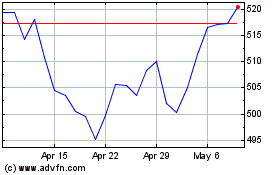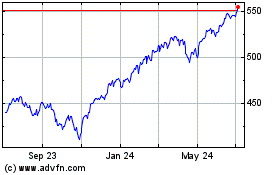ETF Issuer Solutions Welcomes Industry Newcomers
November 18 2014 - 9:00AM
ETFDB
Innovation has long been one of the driving forces behind the
expansion of the exchange-traded universe. Most recently,
innovation has struck the industry in the form of a comprehensive
platform designed to help investment managers bring their
strategies to market: enter ETF Issuer Solutions. We recently
talked with the president of ETF Issuer Solutions, William
Smalley, who shared his firm’s story, their objective,
and insights surrounding the industry as a whole [see also
Recent ETFdb Interviews].
ETF Database (ETFdb): What was the inspiration behind
creating ETF Issuer Solutions?
William Smalley (WS): The genesis of the ETFis platform
came from our perspective as product managers at emerging ETF
sponsors. We found that the barriers to entry, both in terms of
product origination and distribution penetration, were daunting and
expensive. We formed ETFis in 2012 to address the challenges that
all new entrants to the space will face.
The ETF industry “grew up” quickly and, frankly, a little
haphazardly. The infrastructure for such a rapidly expanding space
struggled to keep pace with product innovation and tremendous AUM
growth. Much of the technology, operations, and distribution
support were serviced by legacy mutual fund infrastructure and
processes. We felt there was significant demand for a
comprehensive, ETF-specific services model that allows emerging
product issuers to focus on what really matters: strong performance
and effective distribution [see also 7 Charts to Put the ETF
Industry in Perspective].
ETFdb: Who is ETFis targeted towards? Why does it make
sense for them to utilize this platform?
 WS: The ETFis
platform does not necessarily target a particular type of ETF
issuer – we have the regulatory framework and operational
infrastructure to support both index-based and actively managed
ETFs. That said, we see the biggest demand for the platform from
middle market hedge funds, CTAs, and investment advisors who are
seeking to efficiently launch a retail version of their flagship
strategies in an effort to cast a wider net without having to make
a significant investment in internal headcount and regulatory
permissions.
WS: The ETFis
platform does not necessarily target a particular type of ETF
issuer – we have the regulatory framework and operational
infrastructure to support both index-based and actively managed
ETFs. That said, we see the biggest demand for the platform from
middle market hedge funds, CTAs, and investment advisors who are
seeking to efficiently launch a retail version of their flagship
strategies in an effort to cast a wider net without having to make
a significant investment in internal headcount and regulatory
permissions.
Coincidentally, we believe the biggest opportunity for new AUM
growth is in alternative strategies. The “liquid alts” movement has
not yet made its way to ETFs – we are positioning the ETFis
platform as the destination for sophisticated ETFs managed by
specialists in particular asset classes or strategies [see
Alternatives ETF List].
ETFdb: There are some critics who think that ETFs have gone
too far from their initial intention of offering broad-based
exposure to buy-and-hold investors. What’s your take on the
innovation in the ETF industry over the last several years?
WS: We had a period between 2007 and 2009 where ETF product
innovation was focused more on trading vehicles rather than longer
term portfolio tools. The recent wave of smart beta and
actively-managed ETFs are tailored to more closely meet the needs
of the buy and hold investor rather than the day trader. Such
products can be more complex than broad-based beta ETFs, and
typically have somewhat higher management fees, but they have been
successful in raising AUM because they fulfill needs within
portfolios that may be unmet by broad-based ETFs. We continue to be
bullish on these products in large part because they have real
appeal to buy and hold investors of all shapes and sizes.

ETFdb: What are some of the trends you are seeing as far as
what kinds of products are quick to gain momentum? Can exotic ETFs
compete with “proven strategies” in the same space for assets?
WS: Gauging “quick momentum” for new products is very
difficult. The notion that listing an ETF with a great strategy or
index behind it will lead to instant adoption is a fallacy in 2014.
Active/alternative ETFs may not directly “compete” with more
established and less complex ETFs; rather, we often look to garner
market share outside of existing ETF assets – be it hedge funds,
mutual funds, closed end funds, etc. with comparable investment
objectives. These ETFs fall somewhere in between SPY and higher fee
pooled vehicles [see The Cheapest ETF for Every Investment
Objective].
ETFdb: What do you expect in terms of ETF adoption going
forward? What types of investors have been slow to adopt or are
potentially major beneficiaries of embracing ETFs?
WS: We expect increased usage across nearly every channel.
We are paying particular attention to the shifting dynamic in the
investment advisory space – from the transactional brokerage
business to the fee-based wealth advisory model. The rise of the
“ETF Strategist” is no coincidence, in our view. Perhaps the
biggest barriers to fall are in the defined contribution and
insurance channels, though we expect that to come slowly over the
next decade. Those are especially intriguing possibilities to us
because we believe technology solutions will help catalyze adoption
and make distribution ubiquitous and highly scalable.
The Bottom Line
The ETF industry has undeniably democratized the investment
process. However, from an issuer’s perspective, this landscape
remains riddled with nuances; more specifically, the hurdles
associated with starting as well as running an exchange-traded
fund can be quite intimidating. As such, ETF Issuer Solutions
continues to push the innovation envelope forward as it strives to
bring forth compelling strategies and products that might otherwise
not get the attention they deserve.
Follow me on Twitter @SBojinov
[For more ETF analysis, make sure to
sign up for our free ETF newsletter]
Disclosure: No positions at time of
writing.
Click here to read the original article on ETFdb.com.
SPDR S&P 500 (AMEX:SPY)
Historical Stock Chart
From Mar 2024 to Apr 2024

SPDR S&P 500 (AMEX:SPY)
Historical Stock Chart
From Apr 2023 to Apr 2024
